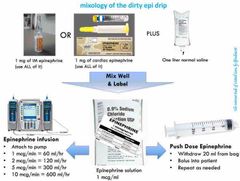![]()
![]()
![]()
Use LEFT and RIGHT arrow keys to navigate between flashcards;
Use UP and DOWN arrow keys to flip the card;
H to show hint;
A reads text to speech;
3 Cards in this Set
- Front
- Back

Transcutaneous pacing:
Indications- (5) |
1. Inject 1 mg of epinephrine into a liter bag of normal saline. to mix well. 2. Push dose: Fill 20 cc syringe with diluted (1 mcg/ml) epinephrine from your one-liter bag. *which will deliver a bolus of 20 mcg epinephrine. Refill your 20 ml syringe and repeat as needed. 3. epinephrine to an infusion pump and set the rate. 60 ml/hour =1 mcg/min infusion 240 ml/hour to = 4 mcg/min infusion 600 ml/hour = 10 mcg/min infusion |
|
|
Transcutaneous pacing Causes of failure to capture? (8) |
1. Electrode placement- Reposition 2. Wrong electrode placement - negative lead goes anteriorly 3. Faulty electrical wires- check connection 4. Battery charged? 5. Poor skin contact- clean and dry skin 6. Increased intrathoracic air- COOD/PTX/NIPPV 7. Pericardial effusion- pericardiocentesis 8. MI/Metabolic cause- correct cause A |
|
|
Symptom bradycardia do 2 simultaneous steps: 1. Electric -(2) ? 2. Medical - (6) ? |
1. Electrical = TCP/trans venous 2. Medical: Atropine-> Epi bolus (~20-50 mcg)/ (2-10mcg/min drip) -> IV Calcium -> Intralipid/glucagon/isoproterenol. |

